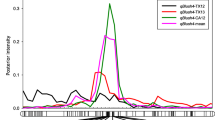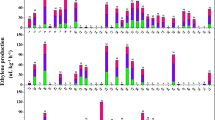Abstract
Fruit acidity is a major determinant of consumer-perceived fruit quality in peach. The non-acid peaches are preferred in the market and this trait is usually selected in commercial breeding programs. A major gene (D/d) located on chromosome 5 of peach has been described for this character, where the non-acid character is determined by the dominant D allele. The corresponding physical location estimated through linkage analysis is 0.9 Mb of the chromosome 5. In our study, we identified a SNP from re-sequencing 129 varieties through genome-wide association studies, and then genotyped a collection of 436 varieties on the Sequenom MassArray platform to verify the single nucleotide polymorphism (SNP) marker for this character. Two hundred and twelve accessions from 224 accessions tasting acid are TT. Two hundred accessions from 212 accessions tasting non-acid are TC or CC. The accuracy rate was 94.5 %. Based on the SNP marker, we also designed primers used for PCR to identify non-acid peaches. This approach was validated on 169 cultivars and 84 offspring. Data were always consistent and 160 cultivars (94.7 %) and 80 offspring (95.2 %) fit the expectations. These three methods of selecting non-acid plants are convenient and readily useful for peach molecular assisted selection.



Similar content being viewed by others
References
Adhikari T et al (2004) Molecular mapping of Stb1, a potentially durable gene for resistance to septoria tritici blotch in wheat. Theor Appl Genet 109:944–953
Altshuler D, Daly MJ, Lander ES (2008) Genetic mapping in human disease. Science 322:881–888
Berüter J (1993) Characterization of the permeability of excised apple tissue 2. J Exp Bot 44:519–528
Borsani J et al (2009) Carbon metabolism of peach fruit after harvest: changes in enzymes involved in organic acid and sugar level modifications. J Exp Bot 60:1823–1837
Boudehri K, Bendahmane A, Cardinet G, Troadec C, Moing A, Dirlewanger E (2009) Phenotypic and fine genetic characterization of the D locus controlling fruit acidity in peach. BMC Plant Biol 9:59
Burton PR et al (2007) Genome-wide association study of 14,000 cases of seven common diseases and 3,000 shared controls. Nature 447:661–678
Consortium IH (2005) A haplotype map of the human genome. Nature 437:1299–1320
Crisosto CH, Valero D (2008) Harvesting and postharvest handling of peaches for the fresh market. In: Layne DR, Bassi D (eds) The peach: botany, production and uses. CABI, London, pp 575–596
Dalmau R, Iglesias I, Casals M, Bonany J, Carbó J, Montserrat R (2005) Innovación varietal en melocotonero: espeical referencia a la nuevas variantes de nectarina. Fruticultura profesional 152:6–36
Delwiche M, Baumgardner R (1983) Ground color measurements of peach. J Am Soc Hortic Sci 108:1012–1016
Delwiche M, Baumgardner R (1985) Ground color as a peach maturity index. J Am Soc Hortic Sci 110:53–57
Dirlewanger E, Pronier V, Parvery C, Rothan C, Guye A, Monet R (1998) Genetic linkage map of peach [Prunus persica (L.) Batsch] using morphological and molecular markers. Theor Appl Genet 97:888–895
Eduardo I et al (2014) Development of diagnostic markers for selection of the subacid trait in peach. Tree Genet Genomes 10:1695–1709
Etienne C, Moing A, Dirlewanger E, Raymond P, Monet R, Rothan C (2002a) Isolation and characterization of six peach cDNAs encoding key proteins in organic acid metabolism and solute accumulation: involvement in regulating peach fruit acidity. Physiol Plantarum 114:259–270
Etienne C et al (2002b) Candidate genes and QTLs for sugar and organic acid content in peach [Prunus persica (L.) Batsch]. Theor Appl Genet 105:145–159
Frazer KA et al (2007) A second generation human haplotype map of over 3.1 million SNPs. Nature 449:851–861
Gasic K, Quick R, Abdelghafar A, Frett T, Rauh B, Reighard G (2014) Marker assisted breeding for red skin coloration in peach. In: Plant and animal genome XXII conference, Plant and animal genome, 2014
Gupta SK, Charpe A, Koul S, Prabhu KV, Haq QMR (2005) Development and validation of molecular markers linked to an Aegilops umbellulata-derived leaf-rust-resistance gene, Lr9, for marker-assisted selection in bread wheat. Genome 48:823–830
Herbers K, Sonnewald U (1998) Molecular determinants of sink strength. Curr Opin Plant Biol 1:207–216
Ho L (1996) The mechanism of assimilate partitioning and carbohydrate compartmentation in fruit in relation to the quality and yield of tomato. J Exp Bot 47:1239–1243
Huang X et al (2010) Genome-wide association studies of 14 agronomic traits in rice landraces. Nat Genet 42:961–967
Iglesias I, Echeverría G (2009) Differential effect of cultivar and harvest date on nectarine colour, quality and consumer acceptance. Sci Hortic 120:41–50
Kader AA, Heintz CM, Chordas A (1982) Postharvest quality of fresh and canned clingstone peaches as influenced by genotypes and maturity at harvest. J Amer Soc Hort Sci 107:947–951
Khan SA, Beekwilder J, Schaart JG, Mumm R, Soriano JM, Jacobsen E, Schouten HJ (2013) Differences in acidity of apples are probably mainly caused by a malic acid transporter gene on LG16. Tree genet genomes 9(2):475–487
Martinoia E, Massonneau A, Frangne N (2000) Transport processes of solutes across the vacuolar membrane of higher plants. Plant Cell Physiol 41:1175–1186
Meredith FI, Robertson JA, Horvat RJ (1989) Changes in physical and chemical parameters associated with quality and postharvest ripening of Harvester peaches. J Agr Food Chem 37:1210–1214
Reig G, Iglesias I, Gatius F, Alegre S (2013) Antioxidant capacity, quality, and anthocyanin and nutrient contents of several peach cultivars [Prunus persica (L.) Batsch] grown in Spain. J Agr Food Chem 61:6344–6357
Rood P (1957) Development and evaluation of objective maturity indices for California freestone peaches. In: Proc Amer Soc Hort Sci. p 104–112
Ru S, Main D, Evans K, Peace C (2015) Current applications, challenges, and perspectives of marker-assisted seedling selection in Rosaceae tree fruit breeding. Tree Genet Genomes 11:1–12
Sadka A, Dahan E, Cohen L, Marsh KB (2000a) Aconitase activity and expression during the development of lemon fruit. Physiol Plantarum 108:255–262
Sadka A, Dahan E, Or E, Cohen L (2000b) NADP+ -isocitrate dehydrogenase gene expression and isozyme activity during citrus fruit development. Plant Sci 158:173–181
Sardesai N, Nemacheck J, Subramanyam S, Williams C (2005) Identification and mapping of H32, a new wheat gene conferring resistance to Hessian fly. Theor Appl Genet 111:1167–1173
Sosinski B et al (2000) Characterization of microsatellite markers in peach [Prunus persica (L.) Batsch]. Theor Appl Gene 101:421–428
Terrier N, Deguilloux C, Sauvage F-X, Martinoia E, Romieu C (1998) Proton pumps and anion transport in Vitis vinifera: the inorganic pyrophosphatase plays a predominant role in the energization of the tonoplast. Plant Physiol Bioch 36:367–377
Widstrom N, Butron A, Guo B, Wilson D, Snook M, Cleveland T, Lynch R (2003) Control of preharvest aflatoxin contamination in maize by pyramiding QTL involved in resistance to ear-feeding insects and invasion by Aspergillus spp. Eur J Agron 19:563–572
Wu BH, Quilot B, Génard M, Kervella J, Li SH (2005) Changes in sugar and organic acid concentrations during fruit maturation in peaches, P. davidiana and hybrids as analyzed by principal component analysis. Sci Hortic-Amsterdam 103(4):429–439
Yamaki S (1986) Roles of four sorbitol related enzymes and invertase in the seasonal alteration of sugar metabolism in apple tissue. J Amer Soc Hort Sci 111:134–137
Yang Z, Gilbert J, Fedak G, Somers DJ (2005) Genetic characterization of QTL associated with resistance to Fusarium head blight in a doubled-haploid spring wheat population. Genome 48:187–196
Yoshida M (1970) Genétical studies on the fruit quality of peach varieties. I. Acidity bulletin of the horticultural research station A9 Japan, p 1-15
Acknowledgments
This work was supported by the Hi-Tech Research and Development (863) Program of China (2013AA102606);Research Team of CAAS(CAAS-ASTIP-2015-ZFRI-01).
Author information
Authors and Affiliations
Corresponding author
Ethics declarations
Conflict of interest
The authors declare that they have no competing financial interests.
Electronic supplementary material
Below is the link to the electronic supplementary material.
Rights and permissions
About this article
Cite this article
Wang, Q., Wang, L., Zhu, G. et al. DNA marker-assisted evaluation of fruit acidity in diverse peach (Prunus persica) germplasm. Euphytica 210, 413–426 (2016). https://doi.org/10.1007/s10681-016-1709-z
Received:
Accepted:
Published:
Issue Date:
DOI: https://doi.org/10.1007/s10681-016-1709-z




